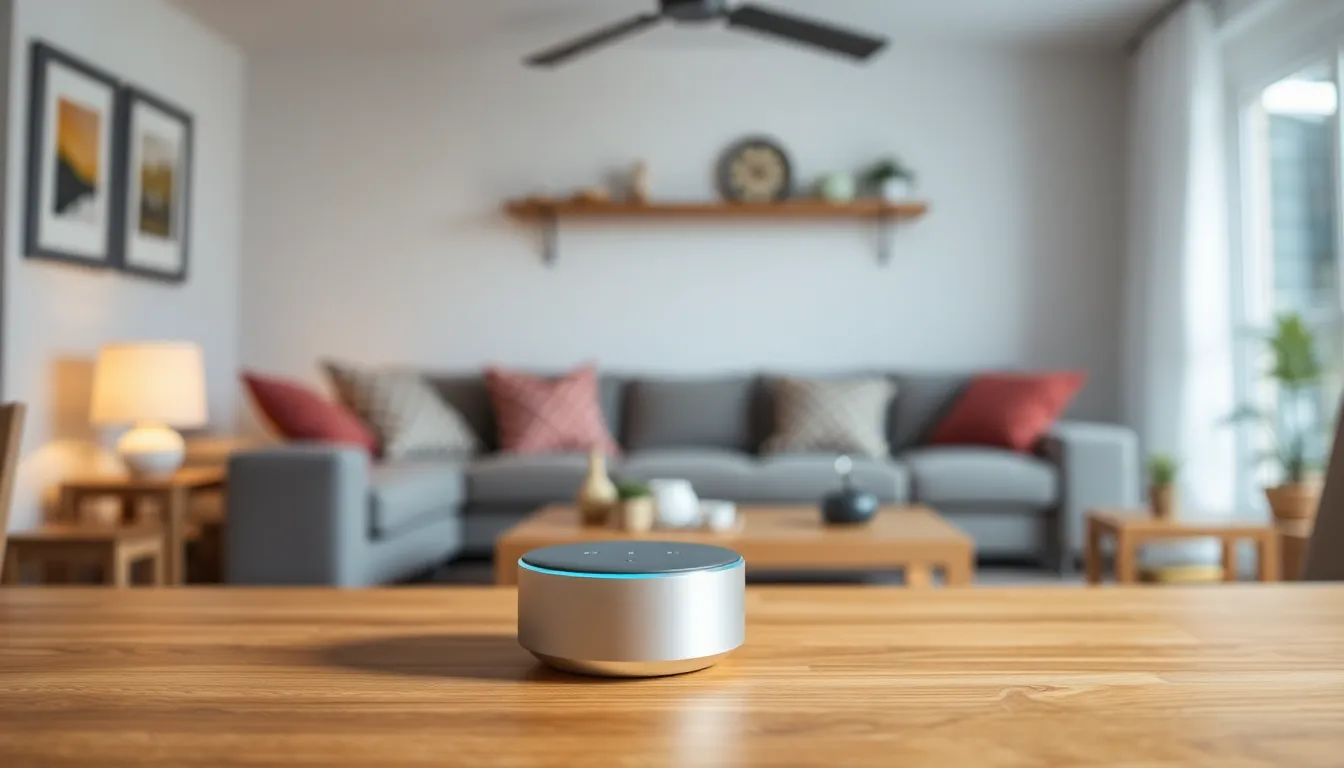In a world where toasters can tweet and fridges can order groceries, the Internet of Things (IoT) has revolutionized daily life. But with great connectivity comes great responsibility—or at least, a few more headaches. As these smart devices invade homes and businesses, the question of security looms larger than a Wi-Fi router in a crowded coffee shop.
Imagine your smart thermostat giving away your vacation plans to a hacker while your security camera becomes a spectator to the chaos. It’s not just a techie nightmare; it’s a reality that demands attention. Understanding IoT security isn’t just for tech gurus; it’s essential for everyone who values their privacy and peace of mind. Dive into the world of IoT security to discover how to keep those pesky digital intruders at bay and ensure your smart devices stay smart, not silly.
Table of Contents
ToggleOverview of IoT Security
IoT security encompasses the strategies and measures with the goal of protecting connected devices and networks. Smart devices, such as security cameras and smart thermostats, often lack robust security features. Vulnerabilities in these devices can lead to unauthorized access and exploitation by malicious actors.
Risks associated with IoT devices include data breaches, which might expose personal information, and network intrusions that can compromise home and business systems. Hackers often target poorly secured devices to gain access to larger networks. Regular updates and patches are crucial in mitigating these risks, yet many users neglect this aspect.
Authentication methods play a significant role in enhancing IoT security. Utilizing strong, unique passwords for each device is essential. Two-factor authentication increases security by requiring an additional verification step during device access.
Network security must also be prioritized. Deploying firewalls, utilizing Virtual Private Networks (VPNs), and segmenting networks can greatly reduce vulnerabilities. Monitoring network traffic for unusual activity provides an additional layer of protection.
In addition, user awareness is vital. Educating individuals about potential threats empowers them to take proactive measures. Understanding the risks of connecting various devices helps cultivate a security-minded approach.
Compliance with security standards and regulations should not be overlooked. Organizations that develop or deploy IoT devices must adhere to recognized frameworks to ensure data privacy and protection. Implementing stringent security measures creates a trust relationship with users, enhancing the overall safety of IoT environments.
Common Threats to IoT Security

IoT security faces numerous threats that can compromise personal data and device functionality. Understanding these dangers is vital for implementing effective protective measures.
Malware and Ransomware
Malware poses significant risks to IoT devices. This malicious software infiltrates systems to steal data or disrupt operations. Ransomware, a type of malware, encrypts data and demands payment for its release. As smart devices often lack adequate security features, they can serve as entry points for such attacks. Regularly updating software and employing antivirus solutions helps defend against these threats. A proactive approach reduces vulnerabilities and enhances overall security.
Data Breaches
Data breaches represent a critical threat to IoT security. Hackers frequently target connected devices to access sensitive information like personal or financial details. Breaches typically occur due to weak passwords or outdated firmware. Organizations must implement strong encryption methods and stringent access controls. Users should monitor their devices and regularly change passwords to mitigate risks. By fostering a culture of security awareness, both individuals and companies can effectively shield themselves from data theft.
Best Practices for Enhancing IoT Security
Secure IoT environments require a combination of best practices. Implementing strong security measures not only protects personal data but also enhances overall device functionality.
Device Authentication
Device authentication plays a crucial role in IoT security. Implementing strong and unique passwords for each device prevents unauthorized access. Multi-factor authentication adds an extra layer, ensuring identity verification before granting access. Devices should utilize secure protocols like WPA3 for network connections, significantly reducing the risk of interception. Furthermore, organizations must enforce regular password changes to mitigate vulnerabilities. Effective authentication methods are essential for safeguarding user privacy and maintaining device integrity.
Regular Software Updates
Regular software updates are vital for maintaining IoT security. Outdated firmware often contains exploitable vulnerabilities that hackers can target. Manufacturers frequently release updates to address these security gaps. Users should enable automatic updates on devices whenever possible for continuous protection. Additionally, checking for updates manually helps ensure devices remain secure. Strong version control practices can promote consistent application security across all devices. Staying updated minimizes the risk of attacks and helps maintain the functionality of IoT systems.
IoT Security Frameworks
Implementing effective IoT security frameworks provides a solid foundation for protecting smart devices and networks. Various established guidelines support organizations in enhancing their security posture.
NIST Cybersecurity Framework
The National Institute of Standards and Technology (NIST) Cybersecurity Framework offers guidelines to identify and mitigate risks associated with IoT devices. Focusing on five core functions—identify, protect, detect, respond, and recover—this framework helps organizations create a comprehensive security strategy. Organizations can assess their current systems, prioritizing improvements based on risk levels. Implementing NIST guidelines strengthens an organization’s ability to defend against cyber threats and enhances overall resilience within IoT environments.
GDPR Compliance
General Data Protection Regulation (GDPR) compliance is essential for organizations developing IoT devices that handle personal data. Protecting user privacy stands paramount under GDPR, requiring businesses to integrate security measures from the design phase onwards. Organizations must implement strong data protection practices while ensuring transparency regarding data collection and processing. Additionally, obtaining user consent before data collection is crucial. Adhering to GDPR not only safeguards personal information but also fosters consumer trust, enhancing the organization’s reputation in the market.
Future Trends in IoT Security
Emerging technologies are reshaping IoT security landscapes. Artificial intelligence (AI) plays a significant role in identifying and neutralizing threats in real-time. Automation enhances response times, allowing organizations to address vulnerabilities as they arise.
Blockchain technology also gains traction for securing IoT devices. By providing a decentralized ledger system, it ensures device authentication and data integrity. Immutable records help safeguard against tampering and data breaches.
5G networks introduce improved connectivity but also create new security challenges. Increased device connectivity heightens the risk of unauthorized access. Organizations must prioritize stronger encryption methods and advanced access controls to mitigate these risks.
Edge computing continues to rise, bringing data processing closer to devices. This shift minimizes latency and enhances efficiency. However, it raises concerns about edge device security. Ensuring robust protection at the edge becomes crucial to prevent potential exploits.
Quantum computing is on the horizon, promising significant advancements in data processing. It may also disrupt traditional encryption methods, challenging existing security protocols. Organizations must adapt their strategies to prepare for the implications of quantum advancements.
Regulatory compliance is increasingly crucial. Governments are implementing stricter guidelines such as the GDPR and California Consumer Privacy Act (CCPA). Compliance not only fosters consumer trust but also enhances organizational reputation.
User awareness remains paramount. Education on potential IoT threats enables individuals to take proactive steps in securing their networks. Promoting a culture of security contributes to a safer IoT environment for everyone.
The landscape of IoT security is rapidly evolving as smart devices become integral to everyday life. With the increasing interconnectivity comes a heightened risk of security threats that can compromise personal data and device functionality. Awareness and proactive measures are essential for individuals and organizations alike to safeguard their networks.
Implementing strong security protocols and staying informed about the latest threats can significantly reduce vulnerabilities. As technology advances, embracing innovative solutions like AI and blockchain will play a crucial role in enhancing IoT security. Ultimately, a collective effort toward education, compliance, and robust security practices will foster a safer digital environment for everyone.









